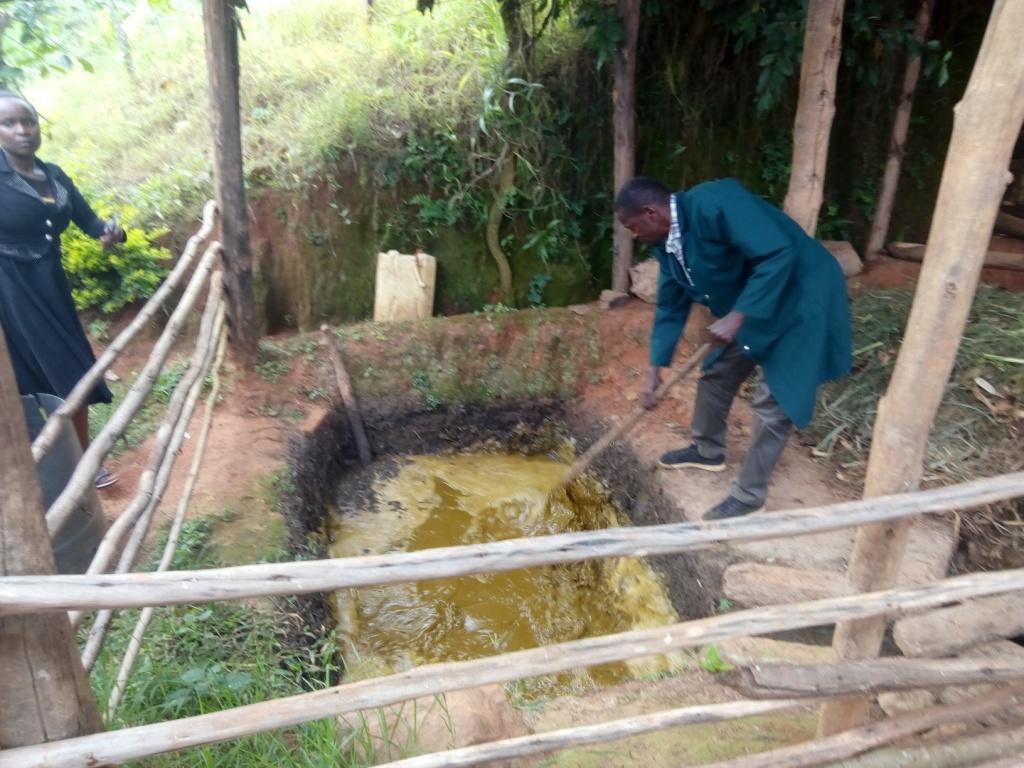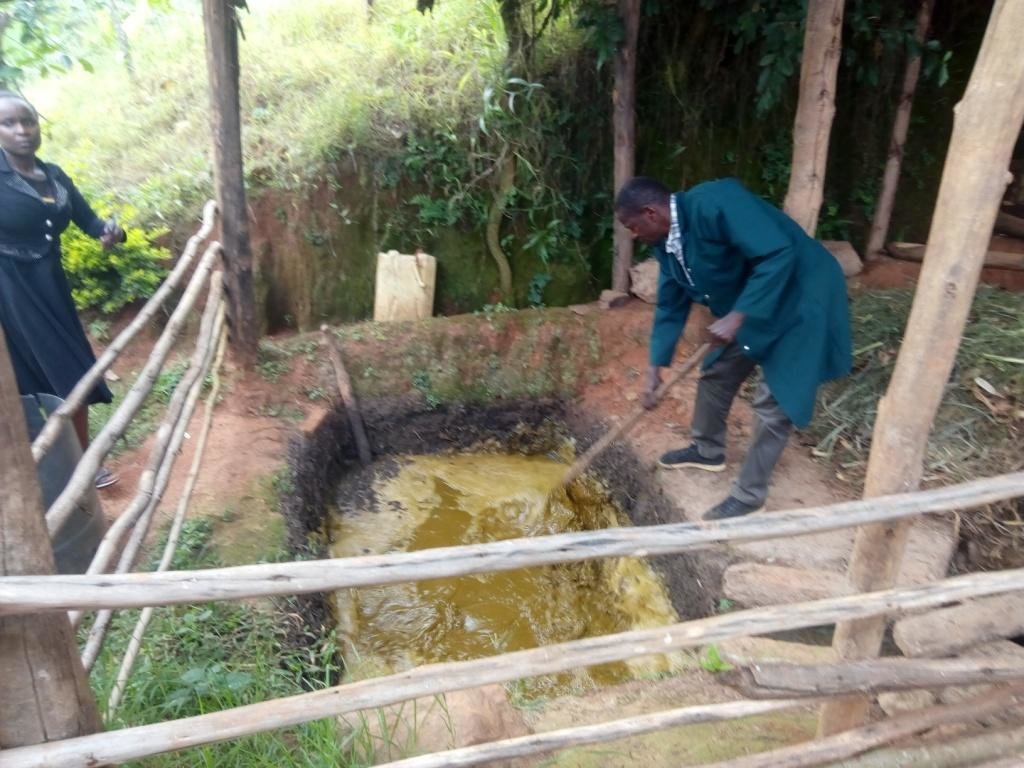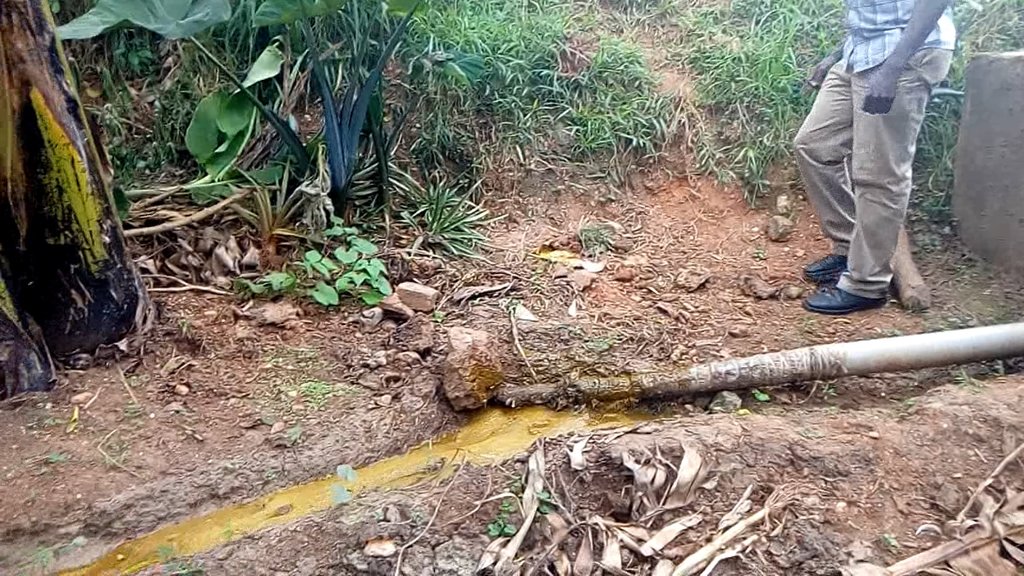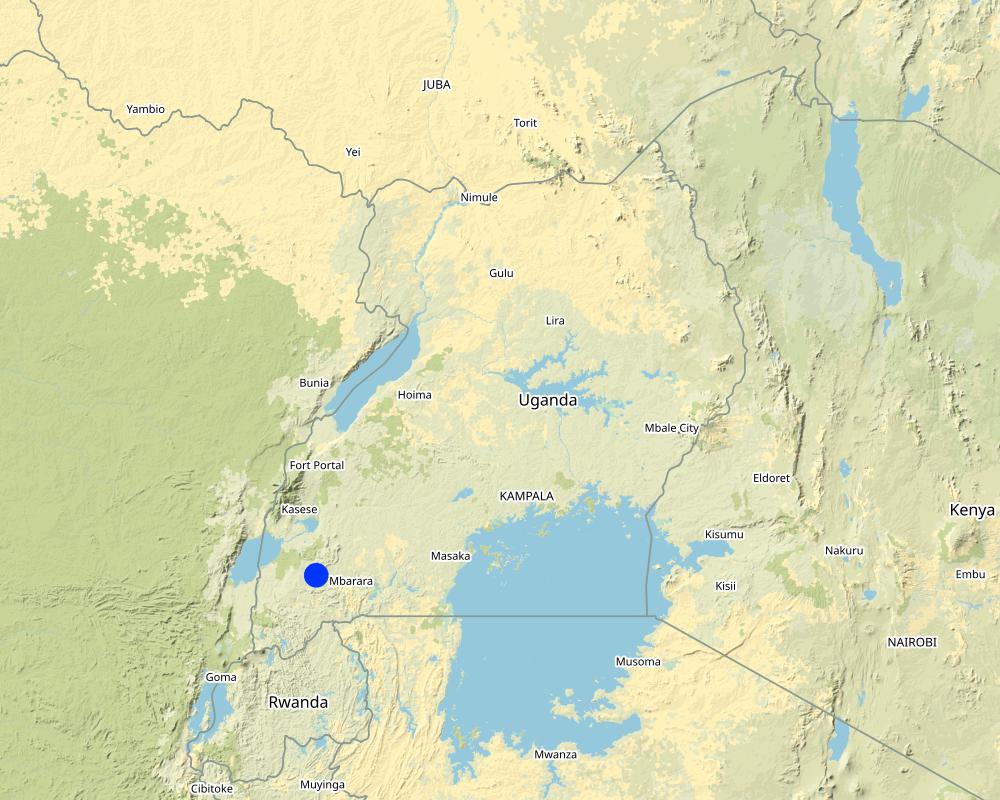BANANA PLANTATION INTEGRATED FERTILIZER-IRRIGATION TECHNOLOGY [乌干达]
- 创建:
- 更新:
- 编制者: Aine Amon
- 编辑者: Drake Mubiru, Kamugisha Rick Nelson
- 审查者: Nicole Harari, Udo Höggel
Okushukyerera na okuteka amasha omurutokye
technologies_3365 - 乌干达
查看章节
全部展开 全部收起1. 一般信息
1.2 参与该技术评估和文件编制的资源人员和机构的联系方式
关键资源人
土地使用者:
有助于对技术进行记录/评估的项目名称(如相关)
Scaling-up SLM practices by smallholder farmers (IFAD)有助于对技术进行记录/评估的机构名称(如相关)
National Agricultural Research Organisation (NARO) - 乌干达1.3 关于使用通过WOCAT记录的数据的条件
(现场)数据是什么时候汇编的?:
23/01/2018
编制者和关键资源人员接受有关使用通过WOCAT记录数据的条件。:
是
1.4 所述技术的可持续性声明
这里所描述的技术在土地退化方面是否存在问题,导致无法被认为是一种可持续的土地管理技术?:
否
注释:
The technology helps improve soil fertility and maintain soil moisture in a banana plantation by using diluted cow dug from a zero grazing kraal.
2. SLM技术的说明
2.1 技术简介
技术定义:
The irrigation fertilizer system is an innovation designed to distribute manure and water in a banana plantation. A kraal (livestock zero grazing shed) with a cow dung reservior, set up uphill and connected with pipes to deliver diluted cow dug to a banana plantation downslope. This reduces the labor required for waste management at the Kraal while maintainig soil fertility.
2.2 技术的详细说明
说明:
The Kraal (livestock zero grazing shed) was initially designed with a waste management system to hold cow dug in a reservoir for 1 to 2 months before being used in a 2-acre garden as manure. However, the farmer faced challenges transporting and distributing manure to the garden which was tedious and time wasting.
The dung from 4 cows is first mixed with water at a ratio of 1 (dung): 3 (water) as it drains into the reservoir producing approximately 1,500 litres of liquid manure monthly. Therefore, a pipe outlet was devised at the base of the cow dung reservoir to transport the waste 50m down-slope into 3 other reservoirs (each 2×1×1m, l×w×h) evenly distributed within the garden. These reservoirs store the liquid manure until the farmer wishes to fertilize the garden.
The garden preparation starts with clearing the weeds and then excavating small trenches that direct the flow of the liquid manure to any direction of interest in the garden. At different points along the flow in the trenches, the farmer opens tributaries leading to pits dug at least 0.75 m away from the banana plantains of interest. The pits made are normally approximately of 12.5 litres capacity. The trenches, tributaries and pits are then covered with soil after a day. This integrated fertilizer-irrigation system can only be possible on farms established on a gently sloping terrain. To set up the system one must have an animal house or any other source of animal dung uphill. The source must be able to provide enough dung to sustain the gardens established downhill.
Alternatively, the system can also be set up with a biogas plant replacing the cow dung reservoir to produce biogas for domestic energy supply and the slurry being used as manure. In case of such modification, the biogas should be set up at a slightly elevated position to give the liquid digestate a gravity force to flow to the garden. A foundation is excavated and a mixing chamber (50 litres capacity) constructed at some distance away from the farm house as well as 3 reservoirs to store the digestate (of a capacity at least 400 litres each) sited in the garden. An outlet pipe is fixed at the bottom of the mixing chamber through which the slurry can be channelled into the garden after the fermentation process producing biogas has stopped.
The construction process of the system without the biogas plant cost the farmer labour worth USD $ 13.44, construction materials were USD $ 251.04 and equipment USD $ 32.25. According to the farmer, the system is averagely expensive in the short run but profitable in the long run.
The system eases waste management and reduces costs of labour. The farmer, over the last 3 seasons realized improvement in the number of banana bunches harvested from averagely 50 to 60 bunches per month. The bunch weight also increased from 8-15Kg to 10-25Kg on average which is important for food security and livelihood.
The impacts of drought on the plantation have reduced compared to the time before adopting the technology. The farmer recommends upscaling since it is easy to manage, it improves productivity and is environment friendly. The major challenge is lack of enough cow dung supply from the kraal and scarcity of water in the dry season. A rainwater harvest system may be constructed to collect and provide water for diluting the cowdung.
2.3 技术照片
2.4 技术视频
日期:
19/01/2018
位置:
Bushenyi, Rwentuha TC, Kitwe
摄影师的名字:
Amon Aine
2.5 已应用该技术的、本评估所涵盖的国家/地区/地点
国家:
乌干达
区域/州/省:
Wester Uganda, Bushenyi
有关地点的进一步说明:
Rwentuha T/C , Kitwe
Map
×2.6 实施日期
注明实施年份:
2016
2.7 技术介绍
详细说明该技术是如何引入的:
- 通过土地使用者的创新
3. SLM技术的分类
3.1 该技术的主要目的
- 改良生产
- 适应气候变化/极端天气及其影响
- 创造有益的经济影响
3.2 应用该技术的当前土地利用类型

混合(作物/放牧/树木),包括农林
- 农林牧业
3.3 有关土地利用的更多信息
该技术所应用土地的供水:
- 雨养
每年的生长季节数:
- 2
具体说明:
March - May and Sept - Nov
3.4 该技术所属的SLM组
- 农畜综合管理
3.5 技术传播
具体说明该技术的分布:
- 均匀地分布在一个区域
如果该技术均匀地分布在一个区域上,请注明覆盖的大致区域。:
- < 0.1 平方千米(10 公顷)
3.6 包含该技术的可持续土地管理措施

结构措施
- S3:分级沟渠、渠道、水道
- S5:大坝、集水斗、水池
- S7:集水/供水/灌溉设备

管理措施
- M3:根据自然和人文环境进行布局
3.7 该技术强调的主要土地退化类型

化学性土壤退化
- Cn:肥力下降和有机质含量下降(非侵蚀所致)

物理性土壤退化
- Pu:由于其他活动而导致生物生产功能的丧失

水质恶化
- Hp:地表水水质下降
- Hq:地下水水质下降
注释:
The system helps in proper management of animal dung for improving soil fertility and soil moisture through the water mixed to form the liquid bio manure matter.
3.8 防止、减少或恢复土地退化
具体数量名该技术与土地退化有关的目标:
- 防止土地退化
- 修复/恢复严重退化的土地
4. 技术规范、实施活动、投入和成本
4.2 技术规范/技术图纸说明
The cowdung reservior of 2 cubic meters (with a capacity of 2000 litre slurry per month). A doom plastic pipe outlet at the bottom of the reservoir drains into the hand dug channels. Trenches of about 0.25 m diameter are constructed to directly drain the flow of the liquid waste to any direction of interest in the plantation. At different points along, tributaries are made leading to points atleast 0.75 m away from the foot of the banana plant. When the trenches fill up, they are left for a day before covering them with soil as manure.
4.3 有关投入和成本计算的一般信息
具体说明成本和投入是如何计算的:
- 每个技术区域
注明尺寸和面积单位:
4 acres of banana plantation fed with cowdung manure from 4 cows under zero grazing
其它/国家货币(具体说明):
Uganda shillings
注明美元与当地货币的汇率(如相关):1美元=:
3638.0
注明雇用劳工的每日平均工资成本:
17000.0
4.4 技术建立活动
| 活动 | 措施类型 | 时间 | |
|---|---|---|---|
| 1. | Excavation of the main reservior | 结构性的 | Best done during the dry season |
| 2. | Construction of the reservoirs | 结构性的 | Best done during the dry season |
| 3. | Establishment of under ground doom pipe | 结构性的 | |
| 4. | Excavation of cannals within the plantation | 结构性的 | When its time to fertilize the plantation |
4.5 技术建立所需要的费用和投入
| 对投入进行具体说明 | 单位 | 数量 | 单位成本 | 每项投入的总成本 | 土地使用者承担的成本% | |
|---|---|---|---|---|---|---|
| 劳动力 | Labour | Man day | 3.0 | 17000.0 | 51000.0 | 100.0 |
| 设备 | Hoe hire | pieces | 2.0 | 5000.0 | 10000.0 | 100.0 |
| 设备 | Panga | pieces | 1.0 | 9999.0 | 9999.0 | 100.0 |
| 设备 | Hammer | pieces | 1.0 | 50000.0 | 50000.0 | 100.0 |
| 设备 | Wheel barrow hire | pieces | 1.0 | 50000.0 | 50000.0 | 100.0 |
| 施工材料 | Cement | 60kg bags | 13.0 | 29000.0 | 377000.0 | 100.0 |
| 施工材料 | Sand | 1 tonne trips | 2.0 | 70000.0 | 140000.0 | 100.0 |
| 施工材料 | Bricks | 1 tonne trip | 1.0 | 270000.0 | 270000.0 | 100.0 |
| 施工材料 | Doom pipe | Meters | 2.0 | 15000.0 | 30000.0 | 100.0 |
| 技术建立所需总成本 | 987999.0 | |||||
4.6 维护/经常性活动
| 活动 | 措施类型 | 时间/频率 | |
|---|---|---|---|
| 1. | Washing the cow dug into the kraal | 管理 | Daily |
| 2. | Mixing water and manure | 管理 | Daily |
| 3. | Construction of trenches and pits in the garden | 结构性的 | |
| 4. | Release of manure into the garden and covering of the pits and trenches | 管理 | After the pits have filled with slurry |
4.7 维护/经常性活动所需要的费用和投入(每年)
| 对投入进行具体说明 | 单位 | 数量 | 单位成本 | 每项投入的总成本 | 土地使用者承担的成本% | |
|---|---|---|---|---|---|---|
| 劳动力 | Labour to clean the cow shed and the reservoir and drain it | Man day | 1.0 | 17000.0 | 17000.0 | 100.0 |
| 劳动力 | Labour to excavate temporary drains | Man per month | 2.0 | 150000.0 | 300000.0 | 100.0 |
| 设备 | Spade | piece | 1.0 | 50000.0 | 50000.0 | 100.0 |
| 设备 | Hoe | piece | 1.0 | 50000.0 | 50000.0 | 100.0 |
| 技术维护所需总成本 | 417000.0 | |||||
注释:
The land user runs the whole facility with his family and the equipment required are readily available. The maintenance costs shown have indicative character for situations in which no family members are available.
4.8 影响成本的最重要因素
描述影响成本的最决定性因素:
Establishment of the reservoirs and the labor required to construct them
5. 自然和人文环境
5.1 气候
年降雨量
- < 250毫米
- 251-500毫米
- 501-750毫米
- 751-1,000毫米
- 1,001-1,500毫米
- 1,501-2,000毫米
- 2,001-3,000毫米
- 3,001-4,000毫米
- > 4,000毫米
农业气候带
- 潮湿的
5.2 地形
平均坡度:
- 水平(0-2%)
- 缓降(3-5%)
- 平缓(6-10%)
- 滚坡(11-15%)
- 崎岖(16-30%)
- 陡峭(31-60%)
- 非常陡峭(>60%)
地形:
- 高原/平原
- 山脊
- 山坡
- 山地斜坡
- 麓坡
- 谷底
垂直分布带:
- 0-100 m a.s.l.
- 101-500 m a.s.l.
- 501-1,000 m a.s.l.
- 1,001-1,500 m a.s.l.
- 1,501-2,000 m a.s.l.
- 2,001-2,500 m a.s.l.
- 2,501-3,000 m a.s.l.
- 3,001-4,000 m a.s.l.
- > 4,000 m a.s.l.
说明该技术是否专门应用于:
- 凸形情况
5.3 土壤
平均土层深度:
- 非常浅(0-20厘米)
- 浅(21-50厘米)
- 中等深度(51-80厘米)
- 深(81-120厘米)
- 非常深(> 120厘米)
土壤质地(表土):
- 中粒(壤土、粉土)
土壤质地(地表以下> 20厘米):
- 粗粒/轻(砂质)
表土有机质:
- 中(1-3%)
5.4 水资源可用性和质量
地下水位表:
5-50米
地表水的可用性:
中等
水质(未处理):
不良饮用水(需要处理)
水的盐度有问题吗?:
否
该区域正在发生洪水吗?:
否
5.5 生物多样性
物种多样性:
- 中等
栖息地多样性:
- 中等
5.6 应用该技术的土地使用者的特征
定栖或游牧:
- 定栖的
生产系统的市场定位:
- 混合(生计/商业
非农收入:
- 收入的10-50%
相对财富水平:
- 平均水平
个人或集体:
- 个人/家庭
机械化水平:
- 手工作业
性别:
- 女人
- 男人
土地使用者的年龄:
- 青年人
- 中年人
5.7 应用该技术的土地使用者拥有或租用的平均土地面积
- < 0.5 公顷
- 0.5-1 公顷
- 1-2 公顷
- 2-5公顷
- 5-15公顷
- 15-50公顷
- 50-100公顷
- 100-500公顷
- 500-1,000公顷
- 1,000-10,000公顷
- > 10,000公顷
这被认为是小规模、中规模还是大规模的(参照当地实际情况)?:
- 中等规模的
5.8 土地所有权、土地使用权和水使用权
土地所有权:
- 个人,有命名
土地使用权:
- 个人
用水权:
- 社区(有组织)
- 个人
5.9 进入服务和基础设施的通道
健康:
- 贫瘠
- 适度的
- 好
教育:
- 贫瘠
- 适度的
- 好
技术援助:
- 贫瘠
- 适度的
- 好
就业(例如非农):
- 贫瘠
- 适度的
- 好
市场:
- 贫瘠
- 适度的
- 好
能源:
- 贫瘠
- 适度的
- 好
道路和交通:
- 贫瘠
- 适度的
- 好
饮用水和卫生设施:
- 贫瘠
- 适度的
- 好
金融服务:
- 贫瘠
- 适度的
- 好
6. 影响和结论性说明
6.1 该技术的现场影响
社会经济效应
生产
作物生产
SLM之前的数量:
50 bunches
SLM之后的数量:
70bunches
作物质量
SLM之前的数量:
10kg bunches average
SLM之后的数量:
18kg bunches averagely
畜牧生产
注释/具体说明:
The hygiene at the cattle kraal has improved
生产故障风险
注释/具体说明:
Increase soil moisture and manure
土地管理
注释/具体说明:
Less labor required to handle wastes from the cattle
收入和成本
农业投入费用
SLM之前的数量:
3 workers
SLM之后的数量:
1 worker
农业收入
注释/具体说明:
Increased production of banana bunches per unit area monthly
工作量
注释/具体说明:
No need for casual labor to fetch manure with baskets
生态影响
土壤
土壤水分
土壤有机物/地下C
注释/具体说明:
Manure from dug is well distributed in the garden
减少气候和灾害风险
干旱影响
注释/具体说明:
Irrigation through the liquid slurry
6.2 该技术的场外影响已经显现
地下水/河流污染
注释/具体说明:
Waste from the cattle is well managed and utilized for manure
6.3 技术对渐变气候以及与气候相关的极端情况/灾害的暴露和敏感性(土地使用者认为的极端情况/灾害)
渐变气候
渐变气候
| 季节 | 气候变化/极端天气的类型 | 该技术是如何应对的? | |
|---|---|---|---|
| 年温度 | 增加 | 好 | |
| 季节性温度 | 湿季/雨季 | 增加 | 好 |
| 季雨量 | 湿季/雨季 | 减少 | 好 |
气候有关的极端情况(灾害)
气象灾害
| 该技术是如何应对的? | |
|---|---|
| 局地暴雨 | 好 |
| 局地雹灾 | 好 |
气候灾害
| 该技术是如何应对的? | |
|---|---|
| 热浪 | 好 |
| 干旱 | 好 |
其他与气候有关的极端情况(灾害)
| 其它(具体说明) | 该技术是如何应对的? |
|---|---|
| 好 |
其他气候相关的后果
其他气候相关的后果
| 该技术是如何应对的? | |
|---|---|
| 延长生长期 | 好 |
| 缩短生长期 | 好 |
| Soil moisture loss | 好 |
6.4 成本效益分析
技术收益与技术建立成本相比如何(从土地使用者的角度看)?
短期回报:
消极
长期回报:
积极
技术收益与技术维护成本/经常性成本相比如何(从土地使用者的角度看)?
短期回报:
消极
长期回报:
积极
6.5 技术采用
- 1-10%
在所有采用这项技术的人当中,有多少人是自发地采用该技术,即未获得任何物质奖励/付款?:
- 90-100%
6.6 适应
最近是否对该技术进行了修改以适应不断变化的条件?:
是
若是,说明它适应了哪些变化的条件:
- 气候变化/极端气候
具体说明技术的适应性(设计、材料/品种等):
The farmer intends to establish a waterreservoir for rain water harvesting
6.7 该技术的优点/长处/机会
| 土地使用者眼中的长处/优势/机会 |
|---|
| Less labour required to manage waste at the cattle kraal |
| The system allows easy manuring of the banana plantation |
| The system enables increase in soil moisture for the banana plantation |
| 编制者或其他关键资源人员认为的长处/优势/机会 |
|---|
| The digester from the biogas plant releases slurry free of microbes hence reduces possible infections |
6.8 技术的弱点/缺点/风险及其克服方法
| 土地使用者认为的弱点/缺点/风险 | 如何克服它们? |
|---|---|
| The system requires constant water supply hence it might be affected by long drought spells due to water scarcity | Construction of water reservoirs |
| 编制者或其他关键资源人员认为的弱点/缺点/风险 | 如何克服它们? |
|---|---|
| The system requires use of enough dung supply from the cows and water which may not be available in the dry season | Establishment of a rain water harvesting system to reserve and provide water though out the year |
7. 参考和链接
7.1 信息的方法/来源
- 实地考察、实地调查
1
- 与土地使用者的访谈
1
- 根据报告和其他现有文档进行编译
1
7.2 参考可用出版物
标题、作者、年份、ISBN:
Fertilizer Information System for Banana Plantation , Yu Shin Shuen November 2017
可以从哪里获得?成本如何?
Open access
7.3 链接到网络上可用的相关信息
标题/说明:
Livestock Waste-to-Bioenergy Generation Potential in Uganda: A Review
URL:
https://www.researchgate.net/publication/321116494_Livestock_waste-to-bioenergy_generation_potential_in_Uganda
标题/说明:
Three farmers’ experiences with putting farm waste to good use
URL:
https://www.monitor.co.ug/uganda/magazines/farming/three-farmers-experiences-with-putting-farm-waste-to-good-use-1541896
链接和模块
全部展开 全部收起链接
无链接
模块
无模块





